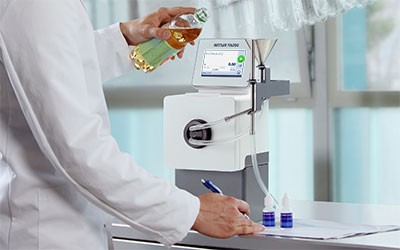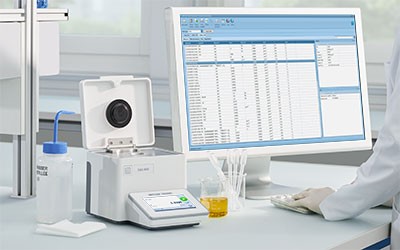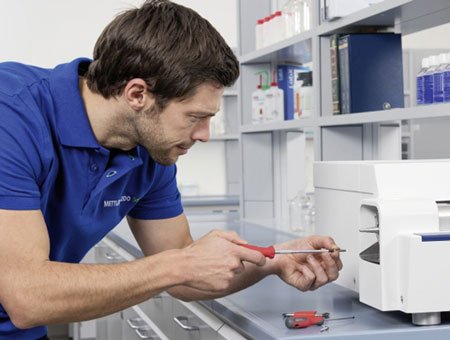We support and service your measurement equipment through its entire life-cycle, from installation to preventive maintenance and calibration to equipment repair.
Please choose your equipment type:

A refractometer (or brix meter), is an analytical instrument that uses a high-resolution optical sensor to measure the total reflection of a light beam that is in contact with a sample. The total reflected light is calculated and the refractive index value is displayed on the instrument, which can be converted into brix, HFCS or other concentrations. Our refractometers are a synonym for accuracy, speed and simplicity. Choose from a robust portable solution to an accurate benchtop brix meter.

Our refractometers master measurements of a wide variety of applications and samples including: Brix, sugar content, refractive index or concentrations of highly volatile, dark, pasty or even solids samples.
Confirmed by our customer: “The Refractometer is very easy to use and has been very reliable. It has made product analysis much easier for our operators” Roy, Kraft Heinz, USA

We have thousands of happy customers worldwide – from family-owned companies to multinational corporations. Our instruments are built to perform, providing reliable and efficient quality control to every customer.

Engineered with high quality components to guarantee a long lifespan, our refractometers can withstand rough environments, in the laboratory, on the factory floor or on-the-go!

Our software solutions provide increased workflow efficiency and data management, connectivity across multiple instruments, reliable data integrity and more.

From portable refractometers to the most compact benchtop meters, our instruments are designed with the user in mind. The intuitive touch screen interface allows you to perform measurements quickly and efficiently.

You can rely on our service technicians and application experts to support you in the areas you need it the most. From ensuring maximum uptime with preventative maintenance to user training and consultations.

We support and service your measurement equipment through its entire life-cycle, from installation to preventive maintenance and calibration to equipment repair.
Please choose your equipment type:

A digital refractometer, also known as a brix meter, uses the total reflection method to measure the refractive index or related values of a liquid sample. This measurement is done digitally, reducing operator influence considerably. Accuracy of up to 0.00002 or 0.01% Brix can be reached, using a small sample volume (0.5 to 1 mL) and conducted in a short measuring time (a few seconds).
Digital refractometers use a light-emitting diode, a sapphire prism and a high-resolution optical sensor. A sample is put on the prism and the measurement is started. From a certain angle of incidence – the so-called critical angle – the ray of light no longer penetrates the sample, but is fully reflected from its surface and is detected by the optical sensor. The refractive index is calculated from this critical angle. In addition, benchtop digital refractometers / brix meters use a built-in Peltier thermostat to control the temperature of a sample.
The refractive index of a solution can be measured manually or digitally. Manual methods like a portable optical refractometer or an ABBE optical refractometer are widely used for the determination of refractive index and related values, e.g. BRIX°, alcohol %, Baumé, Plato, etc. Although these methods are easy to use and quite inexpensive, they require expertise in every step of the manual operation protocols, which often affects the accuracy and reliability of the results. Digital refractometers / brix meters are available as benchtop and handheld instruments. They measure liquid samples digitally, reducing operator influence considerably.
Compare digital refractometers with manual methods: View the different measuring techniques
For most bench-top refractometers the typical volume is around 0.5 mL for samples with high surface tension and 1mL for samples with low surface tension. As only a few drops are required, the temperatures of the sample and the measuring cell equalize fast and the analysis therefore takes only a short amount of time.
This depends on the temperature difference between the sample and the measuring cell, as well as the sample type and the required accuracy of the measurement. This measuring time is typically a few seconds.
Usually refractometers / brix meters are adjusted with water at a specific measuring temperature. This temperature is controlled with a Peltier element, which can cool down or heat up the measuring cell to a specific temperature (e.g. 20°C). Sometimes, Brix standards are used to adjust a refractometer for the measurement of sugar concentrations. These Brix standards are often produced onsite. Smart BRIX Standard Preparation can be done using a balance and a refractometer connected to LabX™ PC software, increasing accuracy and traceability, while eliminating transcription errors.
Learn more about how to test and adjust your digital refractometer.
Digital refractometers / brix meters were originally designed for measuring homogeneous liquids. In reality, many other samples can successfully be measured, such as pasty samples or even foils. These specific samples require some additional accessories, like a press or a foil stamp. Special care has to be taken for volatile samples (where a flow cell is recommended) or non-homogenous samples where the sample must be stirred/homogenized prior to the measurement. This can be done automatically with the in-beaker homogenizing of the InMotion™ autosampler.